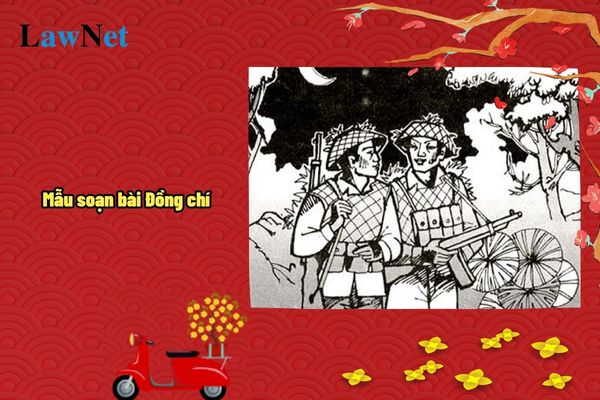What is the sample lesson "Đồng chí" for 8th-grade students in Vietnam? What is the basis for proactively giving orientations in teaching methods for the 8th-grade Literature curriculum by teachers in Vietnam?
What is the sample lesson "Đồng chí" for 8th-grade students in Vietnam?
The poem "Đồng chí" is one of the notable works of anti-French resistance poetry. The poem successfully depicts the noble camaraderie that transcends all boundaries, becoming a symbol of the spirit of solidarity and patriotism of the Vietnamese people.
|
Sample lesson "Đồng chí" for 8th-grade students
|
*Note: The information is for reference only./.

What is the sample lesson "Đồng chí" for 8th-grade students in Vietnam? What is the basis for proactively giving orientations in teaching methods for the 8th-grade Literature curriculum by teachers in Vietnam? (Image from the Internet)
What is the basis for proactively giving orientations in teaching methods for the 8th-grade Literature curriculum by teachers in Vietnam?
Under the General Education Program in Literature issued with Circular 32/2018/TT-BGDDT, the general orientations in teaching methods for the 8th-grade Literature curriculum in Vietnam are as follows:
The Literature curriculum utilizes education methods oriented toward integrated and differentiated teaching; diversifying educational methods, means, and organizational forms; promoting active, proactive, and creative learning, and applying the knowledge and skills of students.
- Based on the program, teachers proactively and flexibly build and organize lessons according to the following orientations:
+ Implement intra-disciplinary integration requirements (both knowledge and skills), interdisciplinary integration, and integrate priority education content (cross-disciplinary); implement differentiated teaching according to student subjects at all levels and differentiation contributing to career orientation in high school education.
+ Train students in methods of reading, writing, speaking, and listening; practice, and experience in receiving and applying knowledge of the Vietnamese language and literature through learning activities in and out of the classroom; focus on using teaching means, overcoming the traditional reading and copying teaching style, developing thinking, training skillful use of means for students.
+ Enhance and promote student activeness and self-reliance; allocate ample time for students to study textbooks and learning materials, practice, conduct presentations, and discussions, and defend learning results to enable students to read, write, speak, and listen according to varying demands and levels; assess and evaluate student task fulfillment in their learning tasks.
Thus, based on the program, teachers proactively and flexibly build and organize lessons oriented towards Grade 8 Literature.
What are the required outcomes regarding reading comprehension in the 8th-grade Literature curriculum in Vietnam?
According to Section IV of the General Education Program in Literature, issued along with Circular 32/2018/TT-BGDDT, the required outcomes regarding reading comprehension in the 8th-grade Literature curriculum in Vietnam are as follows:
READING
READING COMPREHENSION
Literary Text
Reading Comprehension of Content
- State the comprehensive content of the text; recognize significant details, themes, stories, and characters in the text's integrity.
- Identify and analyze the theme, thought, and message the text wants to convey to readers through its artistic form; analyze some bases to determine the theme.
- Recognize and analyze the feelings, emotions, and main inspiration of the writer expressed through the text.
Reading Comprehension of Form
- Recognize and analyze the role of imagination in receiving literary texts.
- Identify some elements of humor and historical stories: storyline, context, character, language.
- Identify and analyze single-line and multi-line plot structures.
- Recognize and analyze the effects of major satirical poetic devices.
- Identify some poetic laws of seven-word quatrains and four-line quatrain poetry such as structure, rules, rhyme, rhythm, and contrast.
- Identify and analyze the uniqueness of a poem expressed through words, images, structure, emotional flow.
- Recognize and analyze some elements of comedy such as conflict, action, character, dialogue, satirical techniques.
Relation, Comparison, Connection
- Understand that each reader may have a unique understanding of a literary text; know how to respect and learn from the understanding of others.
- Comment on the content reflected and the perspective on life, people of the author in the literary texts.
- State any changes in thought, emotions, or lifestyle from reading literary works.
Extended Reading
- In one school year, read at least 35 literary texts (including texts guided for reading on the Internet) with types and lengths equivalent to the learned texts.
- Memorize some favorite poems or excerpts included in the program.
Argumentative Texts
Reading Comprehension of Content
- Identify the argument, main points, reasoning, and typical evidence in the text.
- Analyze the relationship between arguments, main points, reasoning, and evidence; the role of main points, reasoning, and evidence in presenting the argument.
Reading Comprehension of Form
Differentiate objective reasoning and verifiable evidence from the writer's subjective opinions and evaluations.
Relation, Comparison, Connection
Link the content mentioned in the text to modern societal issues.
Extended Reading
In one school year, read at least 9 argumentative texts (including texts guided for reading on the Internet) with lengths equivalent to the learned texts.
Informational Texts
Reading Comprehension of Content
- Analyze the basic information of the text.
- Analyze the role of details in conveying the core information of the text.
Reading Comprehension of Form
- Identify and analyze features of some types of informational texts: texts explaining natural phenomena; texts introducing books or movies; identify the relationship between text features and purposes.
- Identify and analyze how information is presented in the text such as chronological order, causal relationships, importance level, or comparative and contrast methods.
Relation, Comparison, Connection
- Link information in the text to contemporary societal issues.
- Evaluate the expressive effectiveness of a non-linguistic means in a specific text.
Extended Reading
In one school year, read at least 18 informational texts (including texts guided for reading on the Internet) with types and lengths equivalent to the learned texts.

